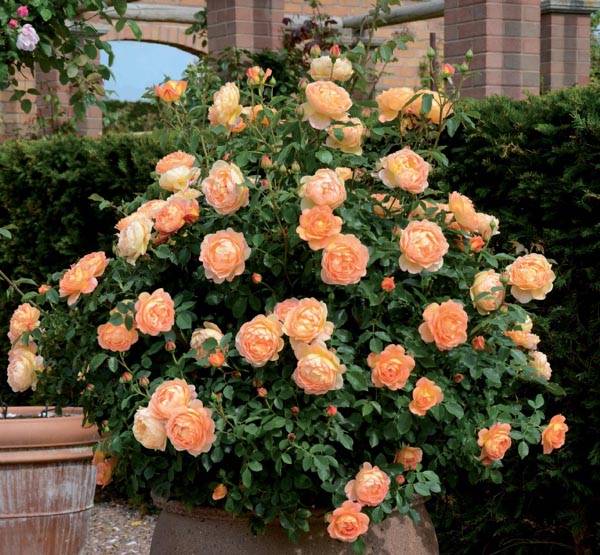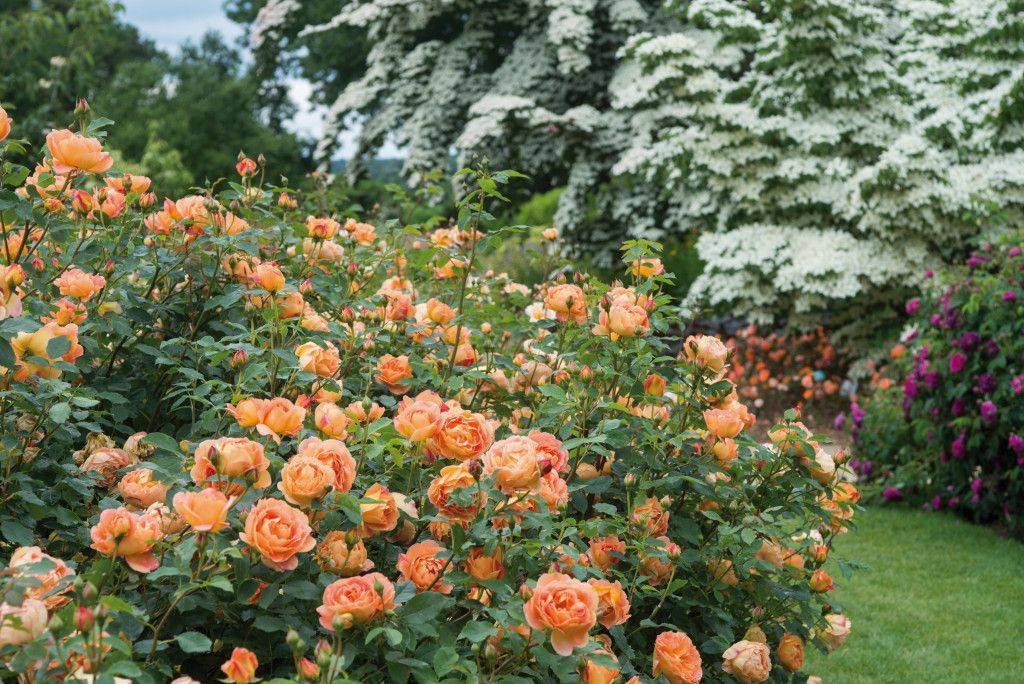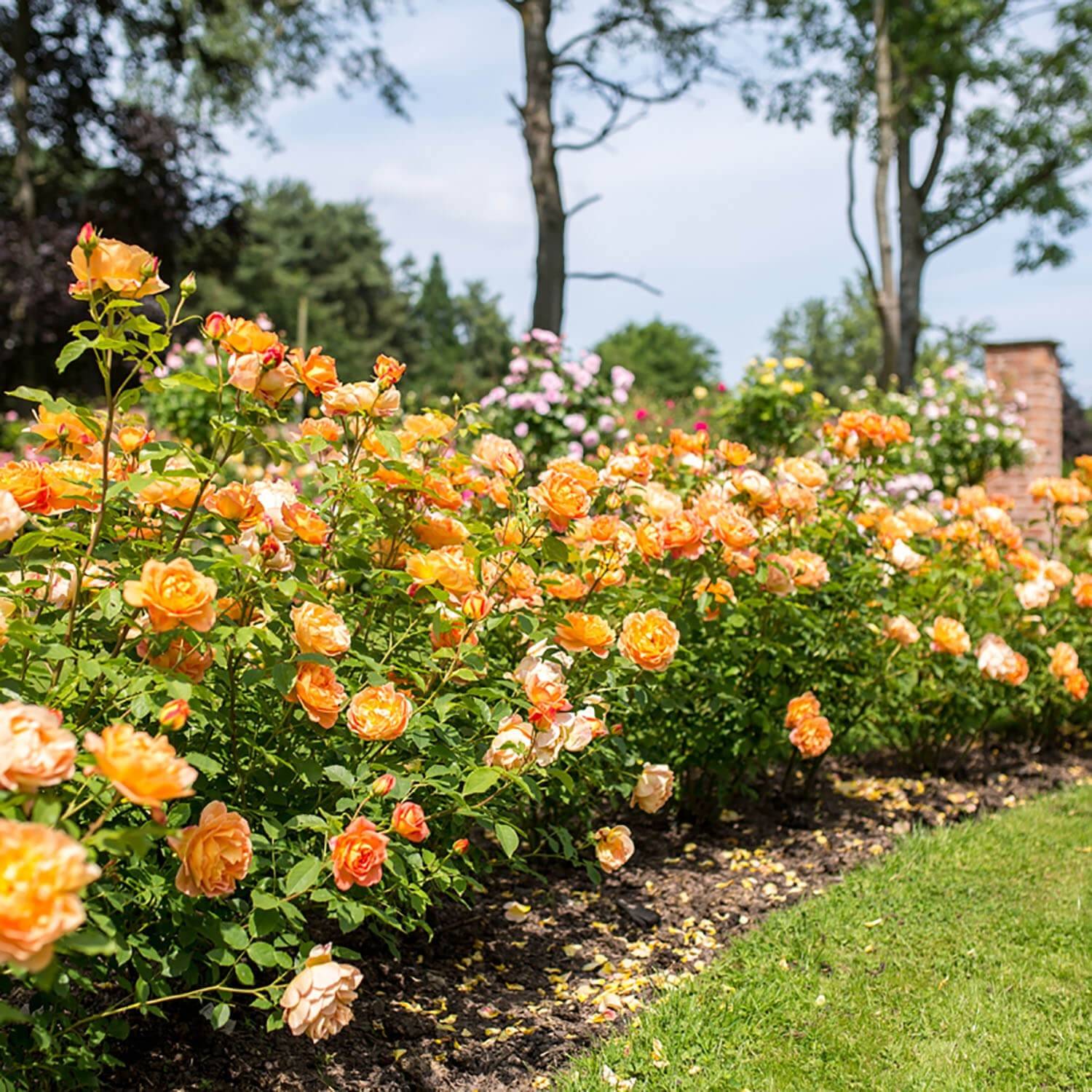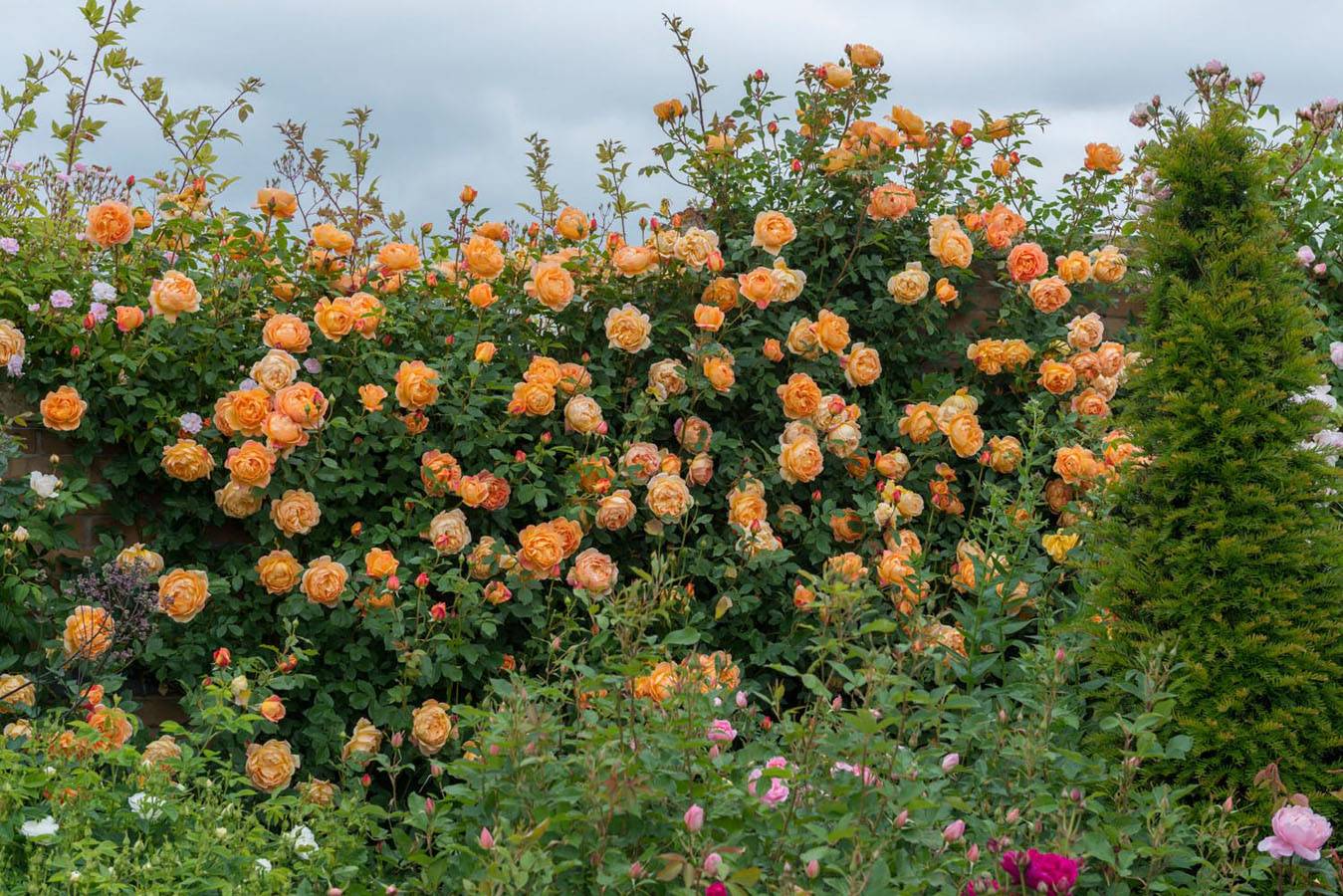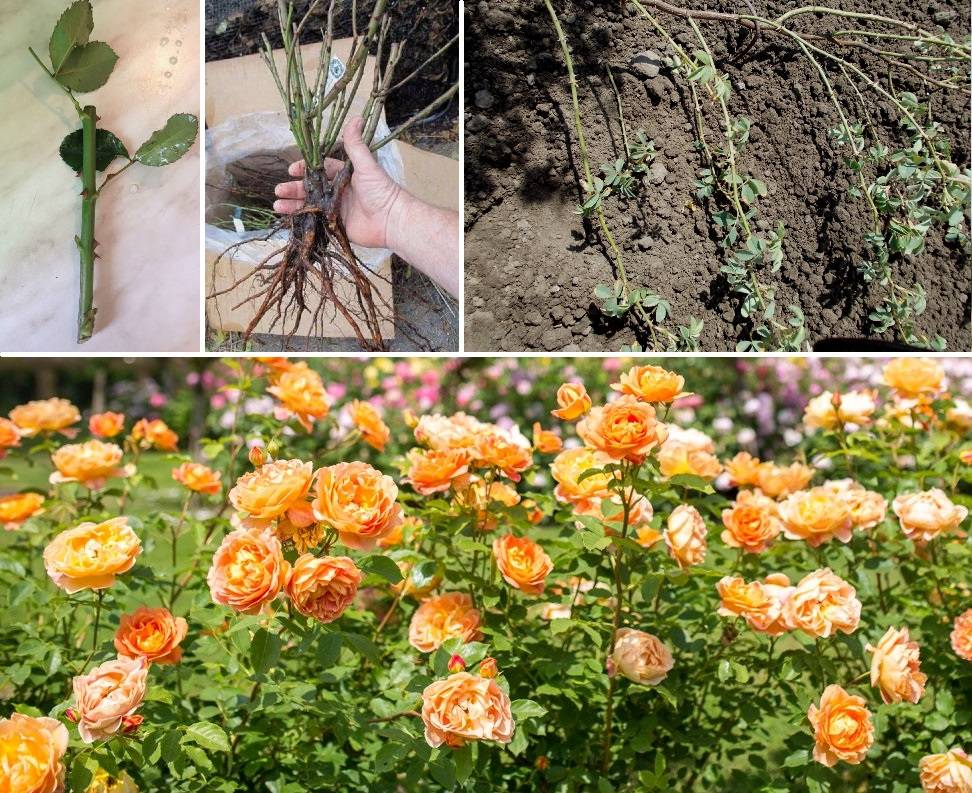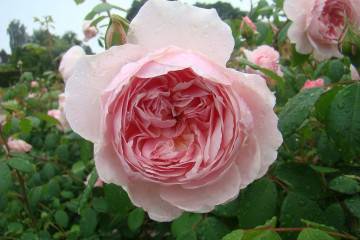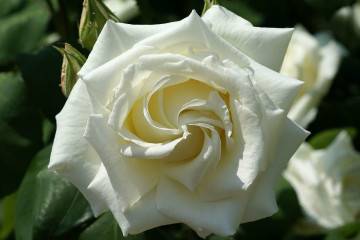Rose Lady of Shalott - characteristics of a shrab
Content:
The Lady of Shalott rose attracts attention with its luxurious peach-colored flowers. The plant is immune to many diseases and is great for inexperienced gardeners.
Rose Lady of Shallot: description and characteristics
The variety appeared quite recently, in 2009. He became one of the last varieties bred by the renowned breeder David Austin. The flower got its name thanks to the poems of Alfred Tennyson about the beautiful sorceress from Shallot, imprisoned in Camelot by King Arthur.
Lady of Shalott is a rose from the group of English park roses. Its powerful and lush shrubs grow up to 1.5 meters in height, covered with dark green leaves. The buds are large, sharpened in the upper part, collected in inflorescences of 3-7 pieces.
The flowers, consisting of 40 petals, reach 10 cm in diameter when fully expanded. Their colors vary from rich salmon to soft apricot, including all possible transitional shades. The aroma is light, with pronounced apple notes.
The special advantages of the variety are:
- Increased winter hardiness;
- long flowering;
- good tolerance to precipitation and high humidity.
The negative characteristics include the tendency of the petals to fade in the sun.
In landscape design, the Shallot rose is usually used as part of bright compositional groups, where it occupies a central position. Looks great against the background of conifers and in the form of a separately growing bush. Can be grown as a trunk.
How to properly plant in open ground and grow a flower
This rose can be grown both outdoors and in a tub. For placement on the site, you must choose a suitable corner where the plant will feel comfortable.
In what form is the landing
As a planting material, Shallot roses are used only by seedlings, which should be purchased at a trusted store. When buying rooted specimens, they are carefully examined, making sure there are no damage and signs of disease. The roots of the seedling should be strong and well developed, the leaves should be fresh and firm.
What time is the boarding
The best time to plant is early fall. A plant rooted before the cold weather overwinters well and will immediately start growing in the spring. If planting is carried out in the spring, then this should be done when the threat of frost has passed, and the soil warms up well.
Location selection
This variety is very light-requiring. With strong shading, the plant will wither and bloom poorly, forming blind shoots. Planted in the wrong conditions, Lady Shallot does not tolerate winter well, she is sick.
How to prepare the soil and flower for planting
The root system of the rose grows over time to a depth of 2 meters. Therefore, in order to protect it from groundwater, it is advisable to make an earthen embankment at the planting site, artificially raising the soil level. The soil at the planting site is well dug up, making it more breathable with the help of river sand and fertilizing (compost or humus).
Seedlings should be carefully examined again before planting in the ground. Unviable roots are removed from them and left overnight in standing water.
Step-by-step planting procedure
When the place is chosen, and the land is prepared, they begin the very procedure of planting the rose. It is recommended to follow these steps:
- Dig a hole 2 bayonets deep with a shovel.
- Place drainage at the bottom, and a pile of earth on top.
- Lower the seedling into the hole, gently spread the roots.
- Sprinkle the roots with earth and compact it with your hands.
- Water and mulch the planting site.
In this case, it is important to ensure that the grafting site of the seedling is not deepened by more than 5 cm.
Plant care
Any richly flowering plant requires special care. Without the timely implementation of the required care procedures, the rose bush will not be able to grow and develop normally.
Watering rules and humidity
A very young rose bush is watered every 2 days, gradually increasing the frequency to 1 time per week. It is important to remember that an excess of moisture in the soil can lead to decay of the roots and death of the plant.
In the spring, when the green mass is actively growing, abundant watering is also required. In summer, an adult bush is watered no more than 1 time in 2 weeks, teaching the procedure only in hot weather.
Top dressing and soil quality
Top dressing of the English rose Lady of Shallot is produced three times per season. In this case, you should adhere to the following scheme:
- At the beginning of May, nitrogen-containing and phosphorus-potassium compounds are introduced, which contribute to the formation of young leaves and the development of the root system.
- After 2 weeks, when the bush begins to gain color, it is fed with potassium and phosphorus.
- 3 weeks after the end of flowering, the rose is fertilized with superphosphate, potassium salts and organic matter so that it can form flower buds for the next season.
Pruning and replanting
Spring pruning is carried out to renew the rose bush and stimulate its subsequent flowering. At the same time, I remove all dried and damaged shoots, and the remaining branches are shortened quite a bit.
The autumn procedure is designed to prepare the plant for wintering. The bush is given the desired shape, the sections are smeared with copper sulfate, dried leaves are removed from the stems.
Features of wintering a flower
Although Lady of Shallot is able to withstand frosts down to -27⁰C, it is recommended to additionally cover her. Before wintering, the plant is sprayed with a fungicide and the soil around it is loosened. After that, the rose is spud, covered with spruce branches and a non-woven fabric is pulled on top.
Blooming rose
The variety belongs to flowering several times per season. If the rose is well looked after, then it will be covered with flowers until the first frost.
A period of activity and rest
The flowering of Lady of Shallot practically does not stop from May to August. Sometimes there may be short rest periods between the flowering waves, but more often they go unnoticed.
Care during and after flowering
Timely removal of dead flowers will contribute to the abundant formation of new buds. The plant does not need any other additional care during the flowering period.
What to do if it does not bloom, possible reasons
Lack of flowering in the first year after planting is considered normal.In subsequent years, the reason may be excessive shading, too frequent watering, as well as the proximity of groundwater. You can cope with the situation by transplanting a plant.
Flower propagation
Shallot is propagated by dividing the bush, cuttings or layering. Germinating seeds is too laborious a process, and the result can be very disappointing, since the varietal characteristics of the plant will be lost.
By cuttings
It is recommended to cut the cuttings at the beginning of June, since it is at this time that they take root best. The bush intended for division is dug out after the snow melts, before the buds appear.
The rhizome is divided into several parts so that each one has viable shoots. All the resulting sections are dipped in crushed activated carbon, after which each new plant is planted according to all the rules.
For cuttings, strong shoots are chosen and cut 20-25 cm long segments with several buds, the lower leaves are cut off. Each stalk should have an oblique bottom cut and a straight top cut. Having withstood the workpieces in a root growth stimulator, they are placed in soil, watered and covered with glass jars, periodically moistening and ventilating.
Layers
It is advisable to lay the layering in the ground in the spring. At the same time, the division of rose bushes is also carried out.
Long flexible branches are chosen to form layering. Shallow cuts are made on their bark, placed in a specially dug groove 10 cm deep, pinned and sprinkled with earth. By the fall, the cuttings will give roots. You can transplant them to a new place already next spring, separating them from the mother bush.
Diseases, pests and ways to control them
Lady Shalotte is a rose resistant to some typical fungal diseases such as powdery mildew and black spot. Most often, gray rot and chlorosis are dangerous for Shallot. The reason is unfavorable growing conditions - lack or excess of moisture, excessive shading, soil depletion.
Of the pests, spider mites, scale insects and a bear can annoy. They fight them with insecticides, using strictly according to the instructions.
Knowing the peculiarities of planting and caring for the Lady of Shallot rose, you can grow it on your site. With proper care, its abundantly flowering bush will become a real garden decoration.
